Related Research Articles
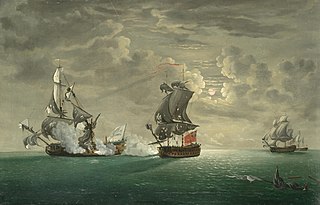
HMS Monmouth was a 66-gun third-rate ship of the line of the Royal Navy, and was likely named for James, Duke of Monmouth. She served from 1667 to 1767, winning ten battle honours over a century of active service. She was rebuilt a total of three times during her career—each time effectively becoming a completely new ship.

René Trouin, Sieur du Gué, also known as René Duguay-Trouin, was a French naval officer, nobleman, slave trader, and privateer best known for his career during the War of the Spanish Succession. He had a brilliant privateering and naval career and eventually became "Lieutenant-General of the Naval Armies of the King", and a Commander in the Order of Saint-Louis. Ten ships of the French Navy have since been named in his honour.
Cinque Ports was an English ship whose sailing master was Alexander Selkirk, generally accepted as a model for the fictional Robinson Crusoe. The ship was part of a 1703 expedition commanded by William Dampier, who captained the accompanying ship, the 26-gun St George with a complement of 120 men.

HMS Endymion was a 40-gun fifth rate that served in the French Revolutionary Wars, the Napoleonic Wars, the War of 1812 and during the First Opium War. She was built to the lines of the French prize Pomone captured in 1794. Due to her exceptional handling and sailing properties, the Severn-class frigates were built to her lines, although the gunports were rearranged to mount an extra pair of guns per side, the ships were made of softwood and were not built until nearly the end of the Napoleonic Wars.
William Mounsey CB was a British officer of the Royal Navy. He served during the American Revolutionary, the French Revolutionary and the Napoleonic Wars, rising to the rank of Captain.

Sibylle was a 38-gun Hébé-class frigate of the French Navy. She was launched in 1791 at the dockyards in Toulon and placed in service in 1792. After the 50-gun fourth rate HMS Romney captured her in 1794, the British took her into service as HMS Sybille. She served in the Royal Navy until disposed of in 1833. While in British service, Sybille participated in three notable single-ship actions, in each case capturing a French vessel. On anti-slavery duties off West Africa from July 1827 to June 1830, Sybille captured many slavers and freed some 3,500 slaves. She was finally sold in 1833 in Portsmouth.

HMS Blanche was a 32-gun Hermione-class fifth rate of the Royal Navy. She was ordered towards the end of the American War of Independence, but only briefly saw service before the outbreak of the French Revolutionary Wars in 1793. She enjoyed a number of successful cruises against privateers in the West Indies, before coming under the command of Captain Robert Faulknor. He took the Blanche into battle against a superior opponent and after a hard-fought battle, forced the surrender of the French frigate Pique. Faulknor was among those killed on the Blanche. She subsequently served in the Mediterranean, where she had the misfortune of forcing a large Spanish frigate to surrender, but was unable to secure the prize, which then escaped. Returning to British waters she was converted to a storeship and then a troopship, but did not serve for long before being wrecked off the Texel in 1799.
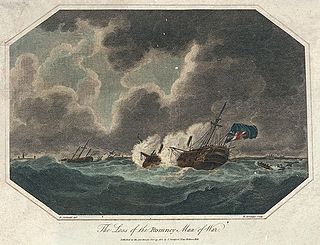
HMS Romney was a 50-gun fourth rate of the Royal Navy. She served during the American War of Independence, and the French Revolutionary and Napoleonic Wars in a career that spanned forty years. Five ships of the Royal Navy have been named HMS Romney. The origins of the name are from the town of New Romney, although it may be that the name entered the Royal Navy in honour of Henry Sydney, 1st Earl of Romney.

HMS Favourite was a 16-gun Cormorant-class sloop of the Royal Navy, launched in 1794 at Rotherhithe. The French captured her in 1806 and renamed her Favorite. However, the British recaptured her in 1807 and renamed her HMS Goree. She became a prison ship in 1810 and was broken up in Bermuda in 1817.
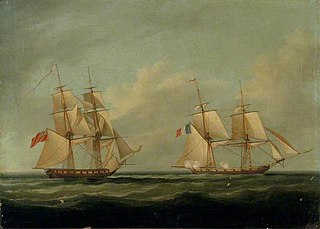
HMS Curieux was a French corvette launched in September 1800 at Saint-Malo to a design by François Pestel, and carrying sixteen 6-pounder guns. She was commissioned under Capitaine de frégate Joseph-Marie-Emmanuel Cordier. The British captured her in 1804 in a cutting-out action at Martinique. In her five-year British career Curieux captured several French privateers and engaged in two notable single-ship actions, also against privateers. In the first she captured Dame Ernouf; in the second, she took heavy casualties in an indecisive action with Revanche. In 1809 Curieux hit a rock; all her crew were saved but they had to set fire to her to prevent her recapture.

HMS Ferret was a Royal Navy Cruizer-class brig-sloop built by Benjamin Tanner at Dartmouth and launched in 1806, 19 months late. She served on the Jamaica, Halifax, and Leith stations during which time she took three privateers as prizes before she was wrecked in 1813.

HMS Brilliant was a 36-gun Venus-class fifth-rate frigate of the British Royal Navy that saw active service during the Seven Years' War with France. She performed well against the French Navy in the 1760 Battle of Bishops Court and the 1761 Battle of Cape Finisterre, but was less capable when deployed for bombardment duty off enemy ports. She also captured eight French privateers and sank two more during her six years at sea. The Royal Navy decommissioned Brilliant in 1763. The Navy sold her in 1776 and she became an East Indiaman for the British East India Company (EIC). Brilliant was wrecked in August 1782 on the Comoro Islands while transporting troops to India.
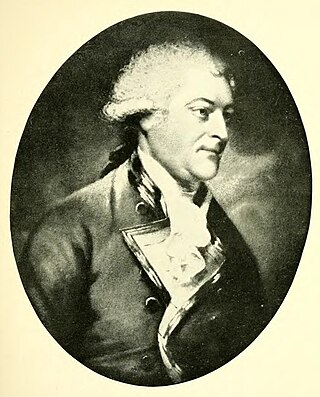
Admiral Robert Linzee was an officer of the Royal Navy who served during the American War of Independence, and the French Revolutionary and Napoleonic Wars.

HMS Nymphe was a fifth-rate frigate of the British Royal Navy, formerly the French Nymphe, lead ship of her class. HMS Flora, under the command of Captain William Peere Williams, captured Nymphe off Ushant on 10 August 1780. Indiscriminately referred to as Nymph, Nymphe, La Nymph or La Nymphe in contemporary British sources, she served during the American, French Revolutionary and Napoleonic Wars. On 19 May 1793, while under the command of Captain Edward Pellew, she captured the frigate Cléopâtre, the first French warship captured in a single-ship action of the war. After a long period of service in which she took part in several notable actions and made many captures, Nymphe was wrecked off the coast of Scotland on 18 December 1810.
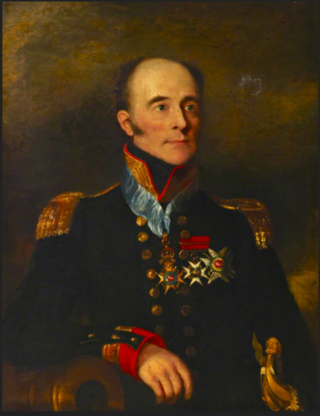
Rear-Admiral Sir Thomas Ussher KCH CB was an Anglo-Irish officer of the British Royal Navy who served with distinction during the French Revolutionary and Napoleonic Wars, and who in 1814 conveyed Napoleon Bonaparte into exile in Elba. He was nicknamed Undaunted Ussher.
HMS Papillon was the French Navy's 12-gun brig Papillon, which the British captured in September 1803. She foundered in September 1805 with the loss of all her crew.
Admiral Sir Hugh Pigot was an officer of the Royal Navy, who served in the French Revolutionary and Napoleonic Wars, and the War of 1812.
Admiral Salmon Morrice was a Royal Navy officer and Vice-admiral of the White.

Antoine Alexis Perier (1691–1757), also known as Perier the Younger, Perier the Cadet, and Perier de Salvert, was a French naval officer appointed to the rank of chef d'escadre in 1752, commander of the order of Saint-Louis.

Rear-Admiral Sir Thomas Hardy was a Royal Navy officer of the late 17th and early 18th centuries. Having joined the navy sometime before 1688, Hardy's career was supported by Captain George Churchill, whom he served as first lieutenant during the Battle of Barfleur in 1692. Promoted to captain in 1693, Hardy served in the Channel Islands and off the coast of England until 1702 when he was given command of HMS Pembroke off the coast of Spain. He fought at the Battle of Cádiz, and subsequently discovered the location of the Franco-Spanish fleet through the intervention of his chaplain, which resulted in the Battle of Vigo Bay. Hardy was knighted for his services.
References
![]() This article incorporates text from a publication now in the public domain : Laughton, John Knox (1887). "Cony, William". In Stephen, Leslie (ed.). Dictionary of National Biography . Vol. 12. London: Smith, Elder & Co.
This article incorporates text from a publication now in the public domain : Laughton, John Knox (1887). "Cony, William". In Stephen, Leslie (ed.). Dictionary of National Biography . Vol. 12. London: Smith, Elder & Co.